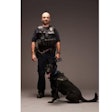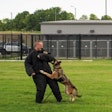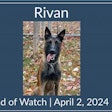With an unlimited supply of public safety emergencies facing communities today, it's never too late for police to plan ahead. It's a simple but powerful precaution and one that more law enforcement agencies are taking to heart in the post-9/11 world.
Ironically, police departments-which excel at responding to emergencies-sometimes fall short when it comes to planning for them. But if controlling uncontrollable situations is at the heart of law enforcement, then pre-incident planning is its lifeblood.
"My job, particularly after 2001, is to be ready for any event that could be conceivable, or rather, inconceivable," says Chief Scott Knight, immediate past president of the Minnesota Chiefs of Police Association and chief of the Chaska Police Department. "Part of being ready means I don't want to wait to call in the necessary resources. I want them to be there."
Firefighters have long been proponents of building preplans, all-hazard drills, and community partnering in the form of mutual aid or multi-agency training. In comparison, police culture is more insular, but can still benefit from pre-incident tactical planning on its own or alongside other public safety groups.
"Law enforcement agencies are actually quite used to working with each other, within their discipline," says Jim Finnell, a former paramedic who is now chief executive of Seattle-based emergency preparedness company Prepared Response Inc. (PRI). "What's new is that you now have completely different disciplines that need to collaborate. It's not just law enforcement; it's the fire service, emergency medicine community, emergency managers, and school resource officers..."
The value of cross-jurisdictional preplanning was recognized at the highest level in 2004, when the Department of Homeland Security set up the National Incident Management System (NIMS), the nation's first standardized emergency-management approach. A highlight of the system is adoption of the Incident Command System, a top-down management model that stresses a standardized command structure for agencies at local, state, and federal levels, as well as for non-governmental aid and support groups.
Part of NIMS requires public safety agencies to create strategic plans and conduct drills with area partners. NIMS mandates aside, police should be doing some type of local preplanning, such as walkthrough tours of potentially vulnerable facilities, for their own benefit.
"One of the main keys to success is to plan early," says Special Agent Timothy Williams, a member of the FBI's Special Events Management Unit. "I don't know if that can be emphasized enough. There is no way you can make up for lost time."
For high-profile events like the 2002 Winter Olympics in Salt Lake City, FBI planning efforts "started four years out, if not more," Williams notes. Those efforts included gathering intelligence threat data, leasing warehouse space to house security operations, and sharing real-time information with other law enforcement partners.
The Spokane Incident
In Spokane, Wash., a long history of interagency cooperation between area police, firefighters, and school officials circumvented a potentially disastrous situation in September 2003 when a disturbed student brought a handgun into Lewis and Clark High School.
Spokane school officials were mindful of the deadly 1999 shooting rampage at Littleton, Colo.'s Columbine High School where 15 people lost their lives. By 2003, Spokane's public school district had created and practiced crisis drills with local responders, and had invested in computerized preplanning software as part of a pilot project.
The results were impressive: During the shooting incident at Lewis & Clark, school officials evacuated 2,000 students from the four-story school and bused them off the property within 20 minutes of the first shot. Police contained the shooting suspect in a science classroom in less than 15 minutes. They shut off natural gas lines to prevent an explosion, and blocked off eight lanes of a nearby freeway. The entire incident ended just one-and-a-half hours later, when the suspect pointed a gun at officers, who shot and wounded him. The suspect was the day's only casualty.
"In Spokane, the fire department, police department, and school district have trained together for years," says Spokane Public Schools Security Director Joe Madsen, a former member of the Spokane Fire Department. "Even prior to Columbine, we had an established working relationship, enabling us to have some of the critical infrastructure in place as far as training, communications, and relationships."
On-site training "was so much better than sitting in a classroom talking about it," says Cpl. Tom Lee of the Spokane Police Department. "We were able to get into schools when there weren't any students there and do mock drills, and had officers and volunteers play the role of students. The benefit of preplanning, combined with training, helps you get to the problem quicker and safer, and determine what other resources might be needed and control it before it gets worse."
Training and planning together also helped people from two different professional cultures-action-oriented police and consensus-building educators-to understand and work together effectively.
"They're probably at two ends of the spectrum in regards to processing issues," Madsen says. "Police and fire understand that we need to participate in (an emergency response) and we realize we need to understand their system."
Recent natural disasters have illustrated how quickly seemingly manageable incidents can spin out of control, even for experienced public safety agencies, observes PRI's Finnell.
"The first responders do a tremendous job, but they're just overwhelmed when they have large scale emergency," Finnell says. "I think it's a reaction to perceived issues related to responding to 9/11 or Hurricane Katrina. Both events showed our political leadership the vulnerabilities of our first-response system."
Narrowing the Field
Fortunately, police do not need to invest in an expensive mapping system or rely on federal agency support in order to tactically preplan for emergencies in their own community. Don't underestimate the value of shoe leather, professional networking, or even low-tech, hand-drawn floor plans.
The first step to preplanning is to narrow the field by determining what events or buildings are most attractive for terrorists or others to target, or most vulnerable to natural disasters and other crisis events.
Facilities where government services could be interrupted or simply sites with a lot of foot traffic such as shopping malls or schools are high-risk properties. Other potentially tricky sites include water-treatment or other sanitation facilities, sporting arenas, freeways that cut through the city, rally points for public demonstrations, or even City Hall.
And don't forget to look at potentially problematic activities, events, and holidays. High-profile events like Fourth of July festivities, labor union strike lines, presidential visits, major sporting events, or controversial gatherings (such as the 1999 World Trade Organization meeting in Seattle) can be magnets for trouble. The facilities where these events will be held should be preplanned.
"First, you have to determine 'Why would I ever be called there?'" says John Gnagey, executive director of the National Tactical Officers Association, in Doylestown, Penn. "Try to learn everything you can about the facility. Not the people who are in it, but the physical facility."
Break Out the Blueprints
When it comes to preplanning and vulnerability analysis, there really is no such thing as too much information. Fire engine companies routinely conduct walkthrough tours of local facilities to identify hazardous materials storage locations, utility shutoffs, elevator and stair access, hydrant locations, and even outside spaces where fire-fighting equipment can be parked safely.
Police also need to know a facility's layout, strengths, and vulnerabilities, says Mauro V. "Buzz" Baldanza, a 27-year policing veteran and captain with the Oceanport (N.J.) Police Department.
"Police look at the crowd control/civil disorder issues, while firefighters look at the fire-hazard issues," Baldanza says. "Oceanport police have looked at different avenues of entry, looked at how the locks function, (and how to gain) quick access to building keys."
Other items Oceanport police have examined and documented during preplans: operation of utility, alarm, ventilation, and video-monitoring systems; staging areas for victims or evacuees; location of outside doors and windows; and potential hostage/barricade locations or vantage points for shooters.
Some building owners welcome police who want to tour their facilities and examine the blueprints in person. Sometimes they aren't so welcoming. If you're having difficulty, city building inspectors or fire inspectors can be a valuable resource. Also helpful are a growing number of companies that offer preplanning software and detailed maps like those made available at Spokane's Lewis and Clark High School.
"As far as I'm concerned, you don't need fancy stuff," says Baldanza. "Paper floor plans, digital photos on laptops, pre-plans in binders, (notations of) entrances, hallways, color coding of hallways, number of exterior doors" are all valuable ways to document a facility's features.
"Don't forget, we are talking about rapid immediate action by officers to active threats, not the opportunity to have mobile command posts and large numbers of people showing up," Baldanza says. "It's the guys and girls on the street (who will be there first), not the SWAT team that will take 30 to 45 minutes to assemble and deploy."
Make the Connections
Identify resources, including educational opportunities and key contacts at other agencies or associations.
One of the tenets of emergency preparedness is that you don't want to meet your response partners for the first time in the middle of a crisis. Make direct contact with other public safety agencies, public works departments, and other community organizations well in advance. Determine whether the organization has developed its own emergency plan, and get names and contact information for key personnel at the facility.
"You're not an island, and need to make the connections," says Chaska, Minn.'s Knight. "It's all about relationships, cooperation, partnerships, and information sharing. These are all things a street cop needs to develop on the beat, that sergeants need to develop as their spheres of responsibility increase, and it's certainly something that a chief of police needs to know before the event."
Identifying funding sources is an important step to creating an effective preplan. Participating in pilot projects and partnering with new businesses or established agencies can also be valuable. Grants are available through the U.S. Department of Homeland Security, Federal Emergency Management Agency, U.S. Department of Justice, U.S. Department of Education, as well as state emergency management divisions.
"The critical piece to receiving those grants is showing collaboration," Madsen says. "Not only on paper, but in practice, working together daily."
Plan, Train, Drill
Join with public safety partners in your city or the surrounding area to develop joint training and in-the-field disaster response exercises. If real-time drills are not an option, tabletop sessions will also prove helpful, and they provide yet another avenue for making professional contacts.
In May 2003, the Seattle Police Department learned the value of mock disaster preplanning when it participated in the massive, weeklong TOPOFF2 weapons of mass destruction drill. While Chicago hospitals role-played a covert bioterrorism release of pneumonic plague, complete with role-playing "plague victims" showing up at local emergency rooms, Washington state first responders and emergency managers wrestled with a simulated radioactive "dirty bomb" explosion in the city's industrial area.
The real-time exercise in Seattle revealed a variety of shortcomings in the emergency response framework, including difficulty communicating radiation terminology among various agencies; uncoordinated release of information to the public, resulting in differing "official" messages; and emergency response centers and agencies operating with incompatible hardware and software.
Not surprisingly, some of the lessons learned also included a call for increased emphasis on coordinated communications between police and fire agencies.
"There are a lot of things the fire department doesn't know that we need," says Lt. Steve Wilske, commander of the Seattle PD's SWAT unit. "And during a critical incident there isn't going to be time to have those discussions."
The bottom line: Knowledge is power, but only if it is freely shared.
And that, really, is what preplanning is all about, gathering information, under non-emergent conditions, so that it is a readily available resource if a crisis does occur. After all, simply knowing how to turn off the deafening fire alarm system at Columbine High School would have drastically improved officers' ability to communicate with each other as they made their way through the chaotic hallways.
In the town of Oceanport-a 3.2-square-mile community in eastern New Jersey-police have already undertaken preplanning of area schools, as well as the sprawling Monmouth Park Racetrack. During much of the year, its 15 police officers serve a town of 6,000 residents; however, during racing season, tens of thousands of visitors descend upon the community daily. Part of preplanning efforts also anticipate an upcoming high-profile event, the 2007 Breeders' Cup World Thoroughbred Championships, which is considered the "Super Bowl" of horse racing.
To Oceanport PD's Baldanza, taking extra effort to know how the facility operates, and what its security strengths and weaknesses are, just makes common sense.
"The better we prepare," he says, "the better the outcome."
Bryn Bailer, a former newspaper reporter, is a contributing editor for Police. By night she is a member of the Tucson Police Department Communications Division.
Preplanning Checklist
Facility preplans can be as basic or comprehensive as you wish. At the very least, they should include this information:
- Contact names/phone numbers
- Facility
- Neighboring Businesses
- Public-Safety partner agencies (local, county, state)
- In-house facility emergency plan (if any)
- Nearest hospital locations and contact information
- Plot plan, floor plans, and site plans
- Site-specific hazards, such as building features or hazardous-materials storage
- Locations of video-monitoring equipment, as well as utility and alarm shutoffs
- Locations identified for landing zones, and staging and evacuation areas
The Incident Command System
A key component of the National Incident Management System (NIMS) is adoption of the Incident Command System (ICS), a personnel- and resource-management framework that clearly defines the needs and expectations of response agencies. It uses a common organizational structure and terminology to improve communication among disparate agencies. Response work is built around five major management areas:
- Command: Those who are in charge
- Operations: Those who do the work
- Planning: Those who receive and give information
- Logistics: Those who provide tools and people
- Finance/Administration: Those who keep track of costs and reimbursements
ICS was created in the 1970s in response to large-scale forest fires in Southern California that required the cooperation of multiple agencies, ranging from small volunteer fire departments, to state emergency management divisions, to the U.S. Forest Service.
Under ICS, the Incident Commander (IC) is the highest authority, and responsible for all aspects of the response, including development of incident objectives and management of all incident operations. Its most notable feature is maintaining a manageable span of control, by limiting how many organizational elements can be directly managed by a single individual (generally, three to seven). As more agencies or resources come into play, ICS enables command to increase the number of individuals managing them.
NIMS strongly encourages emergency response agencies to conduct cross-jurisdictional pre-incident training and exercise drills, in an effort to create a unified yet flexible approach to prevent, prepare for, respond to, or recover from a major incident.
In the coming years, states will be required to be NIMS compliant in order to qualify for federal planning or disaster-assistance funding.
Tactical Preplanning Resources
DisasterHelp
www.disasterHelp.gov
Information clearinghouse for disaster-assistance information for first responders and disaster victims
Emergency Management Institute
www.training.fema.gov/emiweb
Offers an overview of ICS, detailed information about NIMS ICS training, independent study courses, professional links
National Tactical Officers Association
www.ntoa.org
Includes information about training events, professional listings, conferences, tactical Q and A forums
Public Entity Risk Institute
www.riskinstitute.org
Has links to resources in risk and disaster management, as well as an online library, e-training courses and grant opportunities listing
U.S. Department of Homeland Security
www.dhs.gov/dhspublic/theme_home2.jsp
Includes links to grants, training, exercises and information-sharing networks

















